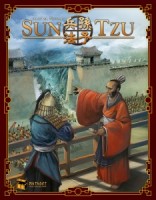
Sun Tzu (Second Edition)
A wargame in just 30 minutes? Well, no. War is certainly the theme du jour in Sun Tzu, but this is a quick 2-player strategic card game that just happens to have a handful of miniatures and a map on which to do battle. One lucky player will champion the heroic Sun Tzu, while the other acts as the tyrannical King Chu. (Note: I’m terrible with history. King Chu may have been a perfectly lovely person. I’m just susceptible to believing everything board games tell me.)
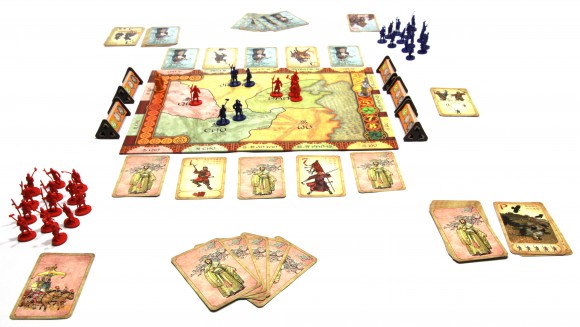
Set Up
In Sun Tzu, the modest board begins the game empty… but there is some set-up to handle around the periphery. Each player has 20 action cards to use through the game – 6 of these need to be fished out prior to the game (boxed numbers 1 to 6 below), while the remaining cards are shuffled to form a draw pile.
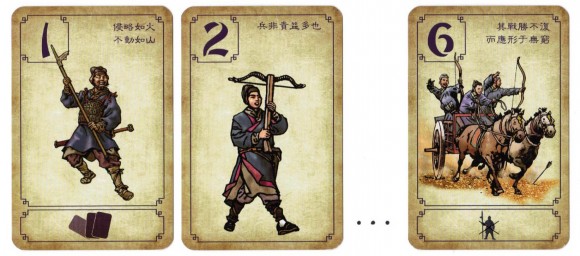
Next, each player blindly draws one of their 5 unique Warlard cards. These are one-time-use cards that serve to vary the players’ powers (the action card deck is identical for both Tzu and Chu). In a typical game you only get one Warlord card, so you’ll need to use it wisely.
To complete your pool of tools, you’ll corral your soldiers – 21 miniatures in each player’s color – and form a reserve on the side of the board.
Sun Tzu is differentiated by a unique feature for determining victory points – triangular displays that roll to highlight changing victory point values awarded to players for controlling each of the board’s 5 regions during the game’s 3 eras. To give the game extra variability, 10 of these displays are included while only 5 are used each game. Setting these up for your first game takes a little extra effort – you’ll need to assemble in addition to simply punching cardboard. In fact, mine needed gluing to stay together. After this initial set-up, you’ll need only to grab 5 of these fellas out of the box and randomly place them by each of the board’s regions.

Scoring and year markers (gold and silver miniatures) are placed on the appropriate tracks, and you’re ready to play! Easy peasy!
Gameplay
The principal mechanic of Sun Tzu is the simultaneous placement of action cards on each of the board’s 5 regions. But before placing your initial 5 cards, you’ll need to draw 4 additional action cards from your draw pile to a hand of 10 (remember the six you fished out above!) This ensures the players aren’t starting with identical hands.
From their hands, each combatant plays 5 of their action cards face-down on each board location in any order they choose. Once both players have placed their cards, the battles occur: the cards at each location are revealed, and the battle’s winner is the player with the highest-value card in the region. That player gets to place a number of troops (miniatures) in the region equal to the difference between their battle amount and their opponent’s.
Each region can have only one player’s troops in it at any time, so if you’ve just won a battle in a region where your opponent has troops, you would remove their troops before placing your own. An example: your opponent has 3 troops in a region you’ve just won by 4. You would remove your opponent’s 3 troops, then add one of your own to the region.
Play continues like this for nine rounds; at the end of rounds 3, 6 and 9 you earn victory points for each region you control – with points scored determined by the triangular displays. Victory points are registered on an “either/or” basis – if you outscore your opponent 9 to 6 in a scoring round, you would move the scoring marker 3 positions in your direction. If either player reaches the 9th position on their side of the scoring track in the 3rd or 6th round scoring phase, the game immediately ends in a bloodbath. Otherwise, the winner is determined at the end of the 9th round, with the winner determined by the location of the scoring marker.
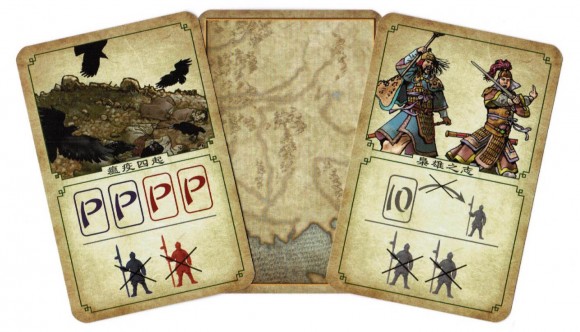
During the game, you may also trigger “events” – these are 5 special cards that take effect when certain things happen in the game. For instance, if you play your “10” card – which is the highest numbered card in each deck – but lose the battle your “10” was played in, you would be forced to lose 2 of your troops. These troops leave your available pool, but can be bought back by sacrificing other powerful cards. Event cards provide additional variability – some games will have no event cards used because the condition was not met for the top card; other games, you’ll run through all of them.
Components
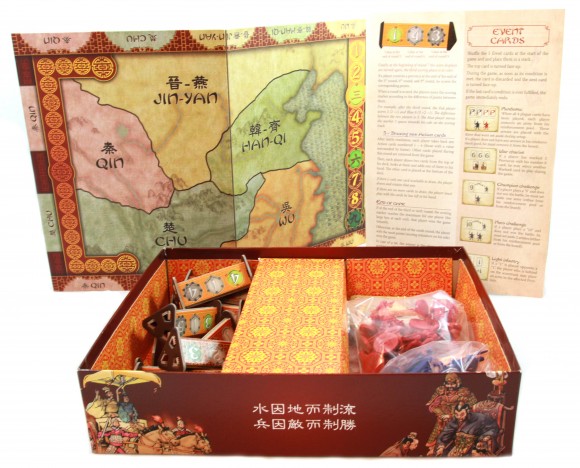
Sun Tzu‘s pastel-colored board is small for a board game, but provides a larger-than-normal surface for a 2-player game. In as little space as possible, it ably handles most of the game’s moving parts (the triangular victory point displays have to sit just off the side of the board).
There are 44 included miniatures – 21 player pieces in each player color, 1 scoring marker and 1 year marker. The 42 player pieces come in 2 different molds – a soldier holding a halberd and one holding a staff. While all the miniatures are fairly delicate, the halberd molds are particularly prone to breaking or severe bending, and must be stored gingerly.

The 55 cards included with Sun Tzu are nicely illustrated and of decent card stock. If you’re averse to sleeving cards, these should stand up to regular shuffling for dozens of plays. All of the cards, regardless of deck, are entirely symbol-driven. There is no text at all, which should help in introducing the game to younger players.
Finally, the only cardboard pieces in the game – the triangular victory point displays – are sturdy, but they are a burden to keep together. If you do not glue them, they will fall apart in the box between plays. This was the only component disappointment for me – it’s always a little annoying to have extra work to keep game parts intact.
Learning Curve
Many 2-player games are easy to learn, particularly card-based 2-player games. Sun Tzu is a 2-player card game, but it has more depth (and parts) than a typical 2-player card game. To its credit, it accomplishes this increased depth without sacrificing ease of learning.
The rulebook is a simple 4-page bifold, easily understandable in one read-through. Everything is there; Sun Tzu is a simple rules/good depth game.
Who would enjoy this game?
Final Thoughts
Sun Tzu should be at the top of the wish list for anybody who relishes 2-player games. While tactical board games are a staple of the 2-player realm, Sun Tzu plays more like a strategic game than a tactical game – particularly surprising given the war/territory control theme.
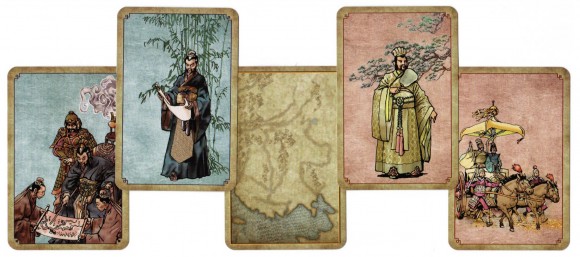
The triangular victory point displays are a wonderful addition to territory control. Some regions will get less valuable as the game goes on – do you load up troops to score heavy points there in the first third of the game, then hope you’ll be able to reallocate them before the region becomes nearly worthless? Or do you go light in the region in the first third of the game, and hope to win the region by a slight margin so you have less work to do in the latter part? Riskier, but if you can pull it off your opponent will be playing from behind. Some regions will get more valuable as the game goes on, while others may have their value peak in the middle third. The triangular displays make it so that every game is different.
We played it 3 times the night we learned it. We had plenty of time to move on to other games, but enjoyed this so much we wanted to play again immediately (it helps that the loser will be anxious to avenge their defeat). Since the Warlord cards make it asymmetrical, you’ll want to “switch sides” between plays, lest your opponent blames your victory on the character assignments. Plus, everybody should get a chance to smite the evil King Chu (again, apologies if this is not historically accurate – history is told by the winner, and in this case, Sun Tzu literally wrote the book!)
User Reviews (0)
Add a Review for "Sun Tzu (Second Edition)"
You must be logged in to add a review.

Be the First to Add a Review!